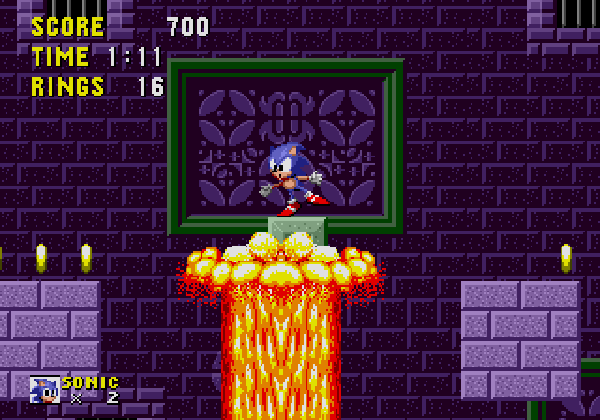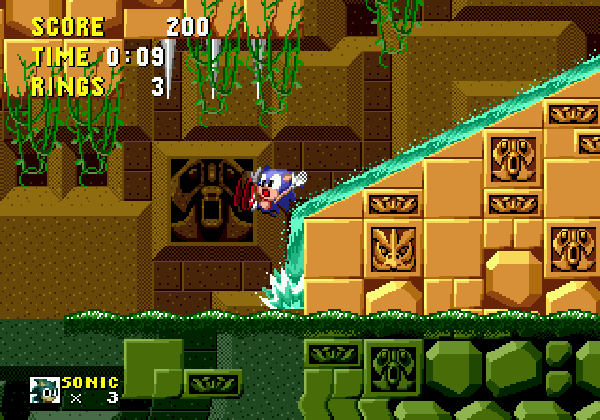
(Review archived from July 29, 2015)
True confessions time. This is the first game I’ve ever beaten for a Sega console. Shocking I know. While I certainly wouldn’t ascribe to being a Nintendo fanboy, I exclusively played Nintendo consoles growing up until such time that I moved on to Sony based hardware. So Sega consoles always had a certain sense of ‘otherness’ to me, and not always in a good way. Whereas first party Nintendo titles exuded polish and pedigree, Sega titles felt scrappy and irreverent. In the 16 bit era when Nintendo was really starting to refine the console gaming experience as something completely separate and distinct from both arcade and computer gaming, many Sega titles still maintained strong ties to the roots of arcade gaming. Whereas Nintendo was the reigning heavy weight champ, Sega was the up and coming bruiser.

Is it a misstatement to say that the Sonic series was the crown jewel of the Sega lineup at this time? For the sake of this mini review, I’m going to say that it was. Here’s what I found interesting about finally playing this game to completion. Whereas history tells us that Sonic was designed and marketed in direct competition with Mario, I find very few actual gameplay similarities between these titles. Sonic was all about the use of big, bold, and beautiful sprite work. Mario at the time was still using smaller sprites. From a control standpoint Sonic relied on a perceived sense of speed and (sometimes barely) controlled momentum. Mario relied on razor sharp platforming, with only small tiny margins for drift. Sonic bosses (although technically all the same villain) were distinctly different from level to level and forced the player to constantly adjust strategies. Mario bosses were relatively staid and utilized a small set of similar (and often repeating strategies). If we’re talking about apples to apples competition it’s actually a bit odd to compare Sonic and Mario, and in point of fact I found a lot more similarities between Sonic the Hedgehog and Donkey Kong Country. That may be a conversation for a different post, but I thought it was an interesting corollary.
Another aspect that I found interesting was that there’s a bit of a disparity between the way that the game was marketed as being a “balls to the wall thrilling speed-fest” (paraphrased), and the way that the game actually plays. In point of fact I would contend that while there are certain sections of the game that encourage putting the pedal to the metal, much of the game requires a more careful and considered approach to the platforming at hand. If you go too fast you might miss some great shortcuts along the way. Even more than that, the game can be a bit malicious with enemy and trap placement in sections that would seem to encourage a speedy approach. In this sense the game often punishes speed in a way that would seem to counter the marketing (and public opinion in general).

The graphics here are absolutely beautiful in a timeless sort of way. This game is one of the finest examples of an all too fleeting era in which 2D sprite based graphics were operating on a level of fine art. It really is a beautiful game to look at, and IMO one of the most visually striking of its era. Sonic the Hedgehog confidently and unerringly set the groundwork for the iconic look and feel of the Sonic series right here at the series inception. It’s really sort of amazing how well conceived this series was straight from the start.
That doesn’t necessarily mean that it’s a perfect game though. The use of larger Sprites means that the platforming can feel less precise, and as you progress further into the game it relies more and more on precise platforming. Compounding the issue of imprecise platforming is that controlling Sonic can feel pretty drifty at times. I suspect part of this issue can be chalked up to the fact that the jumping mid-air ‘turn into a ball’ animation for Sonic is very different from the takeoff and landing animations, although I also don’t think that sums up the entirety of the issue. It’s just a bit of a drifty game. Having said all of that, I doubt that it would much feel like a Sonic game if that drifty feel were tightened up or altered. It’s actually not so bad, once you get used to it, but conversely I think that’s the main driving factor that prevented me from seeing this game through for all these years.

The stages in this game are well executed and rather brilliant. For my money the game hits its high points around the mid-point with the lineup of Spring Yard, Labyrinth, and Star Light Zones. I also need to make special mention of the Special Chaos Emerald Zones in Sonic the Hedgehog. These levels show off the parallax scrolling capabilities of the Genesis in splendid fashion, and while they are (sometimes frustratingly) brief, they are a joy to play. These levels even caught the attention of my wife who is not a gamer, and who rarely pays any attention whatsoever to what I’m playing. “Cool! That looks psychedelic!” she exclaimed. And that in a nutshell encapsulates the universal appeal of Sonic. If a 23 year old game manages to capture my wife’s attention however briefly, it’s doing something (or several things) right.
Usually I end these things with some sort of recommendation summary, but really what is there to say? If you fancy yourself a retro gamer this is required reading playing. I’m a bit chagrined that it took me this long to get around to it.
Leave a Reply